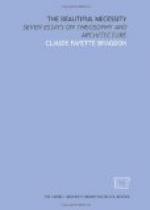The first truth therein published is the law of Unity—oneness; for there is one Self, one Life, which, myriad in manifestation, is yet in essence ever one. Atom and universe, man and the world—each is a unit, an organic and coherent whole. The application of this law to art is so obvious as to be almost unnecessary of elucidation, for to say that a work of art must possess unity, must seem to proceed from a single impulse and be the embodiment of one dominant idea, is to state a truism. In a work of architecture the cooerdination of its various parts with one another is almost the measure of its success. We remember any masterpiece—the cathedral of Paris no less than the pyramids of Egypt—by the singleness of its appeal; complex it may be, but it is a coordinated complexity; variety it may possess, but it is a variety in an all-embracing unity.
The second law, not contradicting but supplementing the first is the law of Polarity, i.e., duality. All things have sex, are either masculine or feminine. This too is the reflection on a lower plane of one of those transcendental truths taught by the Ancient Wisdom, namely that the Logos, in his voluntarily circumscribing his infinite life in order that he may manifest, encloses himself within his limiting veil, maya, and that his life appears as spirit (male), and his maya as matter (female), the two being never disjoined during manifestation. The two terms of this polarity are endlessly repeated throughout nature: in sun and moon, day and night, fire and water, man and woman—and so on. A close inter-relation is always seen to subsist between corresponding members of such pairs of opposites: sun, day, fire, man express and embody the primal and active aspect of the manifesting deity; moon, night, water, woman, its secondary and passive aspect. Moreover, each implies or brings to mind the others of its class: man, like the sun, is lord of day; he is like fire, a devastating force; woman is subject to the lunar rhythm; like water, she is soft, sinuous, fecund.
The part which this polarity plays in the arts is important, and the constant and characteristic distinction between the two terms is a thing far beyond mere contrast.
In music they are the major and minor modes: the typical, or representative chords of the dominant seventh, and of the tonic (the two chords into which Schopenhauer says all music can be resolved): a partial dissonance, and a consonance: a chord of suspense, and a chord of satisfaction. In speech the two are vowel, and consonant sounds: the type of the first being a, a sound of suspense, made with the mouth open; and of the second m, a sound of satisfaction, made by closing the mouth; their combination forms the sacred syllable Om (Aum). In painting they are warm colors, and cold: the pole of the first being in red, the color of fire, which excites; and of the second in blue, the color




